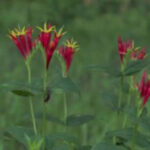|
Ever bloom, Endless Summer hydrangea: Don’t remove the green buds on the lower part of the stems, as these will be the first buds to bloom. The new stem growth occurs at the base of the plant and this is where blooms will emerge later in the summer. Water deeply and slowly until water drips out of the drainage holes. Outdoor winters: cover the base with a thick layer of mulch and wrap the container in burlap or another thick textile to insulate it from the cold. |
|
Spigelia marilandica: 2 to 3 feet tall. Dry soil bog plant. Trumpet red with yellow flowers, yellow-green on the inside, red outside. Blooms upwards, dead-head. Part shade to sun. Moist sandy, rich soil. Blooming at the cusp of spring and summer. This is an excellent garden plant and is easy to start from seed. A perennial, don’t give up on it in the spring. It’s a bit late to awaken and send up its new greenery than many other spring plants. Seeds explosively in July after seed pod have mature and turned black as they ripen. |
|
When transplanting seedlings, wait until 1-2 weeks after the average last frost date when nighttime temperatures are in the 50s. Make sure to space plants accordingly. Place one transplant per 2 square feet. Thin direct sowed plants in the seedling stage to this same spacing. Cannot handle even a light frost (which occurs at 32 degrees Fahrenheit). Water them early in the day and water at the base of the plant to prevent wetting the foliage. As a general rule squash plants require moist, well-draining soil. Water your plants deeply once per week. Acorn squash leaves may wilt slightly in the heat of the day, but fear not, this is not a sign of underwatering. Acorn squash prefers well-drained soil that is rich in organic matter. A layer of compost at the beginning of the growing season will help accomplish this. These plants can create a complex root system that can inhabit the top 8-12 inches of soil. Heavy feeders. Fertilized every 3 weeks during the growing season. Once the plant begins to set fruit then you can switch to a fertilizer low in nitrogen and high in potassium and phosphorus for good fruit development. A liquid fertilizer watered around the drip line of the plant is optimal. With the bush variety, you may consider adding a barrier between the squash and the soil as it begins to mature. Without a barrier, like a piece of slate, the squash may rot on the side that rests on the ground. This is an issue in areas that are especially moist and wet while the fruit is maturing, otherwise, this shouldn’t be an issue. Harvest acorn squash before the first hard frost. Other squashes like this include spaghetti, butternut squash, and pumpkins. You’ll know that they’re ready to harvest when the ribs are dark green, the skin is firm to the touch and the stem begins to turn brown. They continue to ripen slightly after they are harvested and there is no danger in eating an immature fruit. The deep green color of the skin, the browning on the stem, and the dying back of the vine/bush are all great indicators. Once you’re ready to harvest grab a pair of sturdy pruners. Cut the stem about 2-3 inches above the fruit. Leaving some of the stem intact will help lengthen the time that you’re about to store it long term. After harvesting, if there is no acorn squash further down the vine then you will be able to prune back this section so that the plant can focus on ripening any remaining fruit. Leaving the stem attached is an important step as the lack of an intact stem will allow moisture to get inside and rot your acorn squash. They can go through a process of curing outside, in a cool dry place, around 55 degrees Fahrenheit such as a root cellar, garage, or basement. Leave them for a few days until the stem has hardened completely. Acorn squash is one of the most perishable winter squashes. Generally, they can keep for 3-4 weeks but can last even longer in ideal conditions. As mentioned above, acorn squash plants do not appreciate extreme heat. and prolonged temperatures above 90 degrees Fahrenheit can cause the flower to drop, and then the fruit fails to form. In times of intense heat, you can provide your plants with shade cloth to help ease the stress put on them. Like most members of the squash family, acorn squash plants have both male and female flowers. The male flower has a long thin stem and the female flower has a tiny acorn squash shape at the bottom that will turn into a viable acorn squash once it is successfully pollinated. If you notice that the tiny acorn squash is shriveling up then you likely have a pollination issue. If the female flowers fail to get pollinated then they will shrivel up and die rather than producing fruit. Attracting pollinators to your garden with companion plants such as dill, chamomile, nasturtium, and other flowering herbs is beneficial. When all else fails you can easily hand pollinate to ensure fruit production by taking a q-tip and brushing it on the inside of a male flower and then moving it to the inside of a female. |
| Monrovia Magnum Purple New Guinea Impatiens: 8″ height, 14″ spread. Features bold purple round flowers at the ends of the stems from mid spring to early fall. Its pointy leaves remain dark green in color throughout the season. Enormous flowers just above the foliage virtually cover the plant. Bright color for shade to dappled sun. Nearly perfect rounded canopy form is great for hanging baskets or landscape.
Morning sun, afternoon shade. This plant does best in partial shade to shade. It does best in average to evenly moist conditions, but will not tolerate standing water. It is not particular as to soil type or pH. Pruning: Impatiens can become leggy in late summer, especially in deep shade. To promote bushier growth and more flowers, trim off the top 1/3 of the plant. |
| Picardy Clematis: Late, large flowering woody vine. A free flowering, 4″ red/purple flowers that have reddish brown anthers. Prune type 2. Flowering Cezanne Clematis: Early, large flowering, sky-blue, single flowers with yellow anthers. Prune type 2 clematis. Flowering May to July.
These two clematis plants: Grow to a height of 4 feet. Transplant late August. Plant 1-inch above ground level. Suitable for container growing as it is a great bloomer and blooms all along the stem on new growth. Clematis like moist, neutral to sweet soil. This usually translates to approximately 3 gallons of water once a week OR 1” of rainfall a week. Every spring, when the forsythia are in bloom, top dress the soil around the base of the vine with compost or well rotted cow manure and 1-2 tablespoons of lime. Prune Type 2: No need to prune other than tidy up. Thin out and untangle stems before growth begins in late winter or early spring, and then go over the plant again after the earliest flowers fade in late spring or early summer. Generally, these cultivars are only pruned to shape. In the early spring (February or March), prune them lightly above the first pair of new swollen leaf buds, removing about 12 inches from each shoot. Also remove any dead or weak stems at this time. bloom primarily on old wood of the previous season, with a second flush later in summer. Dead and weak vines should be removed in late winter, and remaining vines should be trimmed back to the first buds that are seen to remove dead stems. |
| Huskey Cherry red tomato plants: Full Sun. This super sweet cherry tomato is a best seller because of its flavor, productivity, and good looks. Plant is stout, dark green and really pretty. Short and husky like a determinate type, usually between 3 and 4 feet, yielding clusters of tasty little cherry tomatoes in a small space over a long period of time.
Feed with Miracle-Gro plant food when you transplant, and feeding regularly following label directions for best results. Planting depth: bury 2/3 of the plant. Plant your tomatoes quite deep into the ground. The deeper you root your plants, the stronger they will be as they grow. Plant tomatoes after the threat of frost has passed. Dig holes roughly 15 inches deep (around 40 cm), add compost from cow manure and other organic nutrients, such as bone meal and even smashed eggshells, and cover with soil. Water thoroughly but not too often (twice per week should suffice at first), and try to water early in the day so that plants will dry off before evening. This helps to reduce disease problems. Use drip or soaker hoses whenever possible. |
| Vining Mandevilla: Sun-loving, flowering plants that grow best with 6 to 8 hours of direct light each day for optimum blooms. No deep watering. These vibrant-blooming flowers grow quickly and produce wave after wave of bright flowers—all the way to frost. water 1 – 2 times a week. The plants form storage roots, store water, and need very little of it because their leaves are covered with wax. In very hot spells, however, water the mandevilla daily. Watering more often stimulates growth, but standing water is deadly for a mandevilla. |
| Welcome Blooming Basket in AquaSav Coco Liner. Color Combo: Yellow Bidens #191355, White/Purple Lobelia #19900, Deep Pink Petunias #117355. Full sun, 6 hours. Yellow Bidens: prolific flowering plants with yellow or orange daisy-like blooms. They are also commonly called Spanish needles, tickseed sunflowers, and beggarticks. They thrive in rich soil with sufficient drainage and require full sun. They tolerate drought and heat relatively well. In northern climates with freezing temperatures, they are annuals and will need replanting each year.Lobelia: Bloom time ranges from spring to fall, though it flowers best during cooler months. Performs best with full sun to partial shade and rich, well-draining soil. Choose a site that receives at least 4-6 hours of direct sun.Petunias: Warn weather. 5 or 6 hours of good sunlight; they’ll perform even better when located in full sun all day.The AquaSav Smart Coco Liner is designed to help you grow better, because it’s engineered to be smarter than ordinary liners. Our patented liner starts with a layer of recycled plastic sandwiched between two layers of coco fibers. This layer of plastic creates a built-in water tray that allows just the right amount of water to remain in the liner, giving the soil and roots time to absorb all of the moisture and nutrients. Because the layer of plastic only goes two-thirds up the sides of liner, there is natural air circulation around the plant’s root system, promoting healthy growth. As the basket dries from the top down, water wicks its way through the basket, keeping the soil moist between waterings. This extends time between watering, and the basket never dries out. You’ll have healthy plants that last through the season, only watering about half as often.
|






















